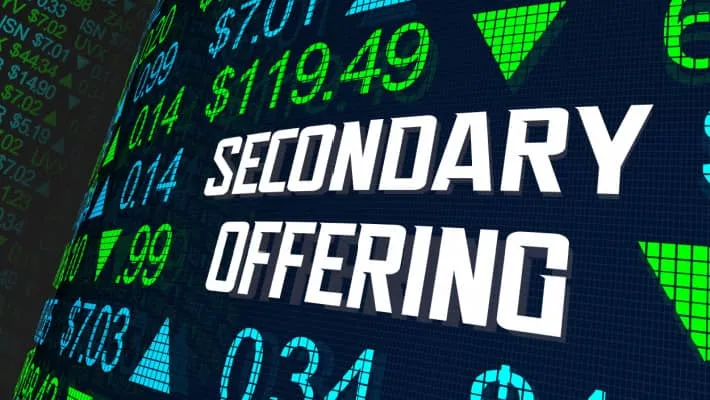Thursday Nov 23 2023 12:47

9 min

Understanding the differences between Secondary Offerings and IPOs is essential for investors looking to navigate the stock market effectively.
In this article, I provide straightforward insights into the unique characteristics of Secondary Offerings, equipping you with the knowledge needed for smarter investment moves without confusing technical language.

A secondary offering pertains to the process by which a shareholder sells a company's stock to other investors on the open market. This activity takes place after the company's initial public offering (IPO), where the first batch of shares is sold directly by the company to the public.
Private enterprises seeking fresh capital often opt for an initial public offering or IPO, where they sell newly issued shares to the public for the first time.
The primary market is the stage for these transactions, and the company typically uses the raised funds for various needs, such as operational expenses, acquisitions, or other strategic purposes.
After a successful IPO, the company's shares trade hands on the secondary market, also known as the stock market.
Here, existing investors have the opportunity to sell their shares to other parties. The key point is that the money from these transactions goes to the individuals or entities selling the shares, not back into the company's coffers.
Occasionally, a business might need more capital post-IPO and can do so through what's known as a follow-on offering.
Such a move is often to secure funds for settling debts, pursuing new acquisitions, or investing in research and development efforts. Moreover, there are times when investors decide to sell off their shares for personal gain.
Alternatively, a business might initiate a follow-on offering to take advantage of lower interest rates to restructure existing debt.
An IPO is the first sale of stock to the public by a company, establishing its place on the stock market, while a secondary offering involves the sale of a company's shares from existing shareholders to new investors after the company has already gone public.
Both affect the company’s capital structure and investor decisions but in distinct ways.
Secondary offerings are market transactions where existing shareholders sell their stock in a public company to other investors, distinct from the company's operations and capital.
Unlike an IPO, where a company sells new shares to raise capital for its own growth, secondary offerings do not involve the creation of new shares and do not provide the company with fresh funds.
These offerings can occur at any time after the company has completed its initial public offering (IPO).
An initial public offering, commonly known as an IPO, marks a company's debut in selling its stocks to the public.
Startups eager to expand, and large private firms aiming for public trading status often go this route. An IPO triggers a well-orchestrated sequence of actions led by a chosen team of underwriters.
This team includes legal experts, accountants, and those well-versed with the SEC's regulations.
They come together to craft a comprehensive prospectus that details the company's financial health, operational insights, leadership background, potential risks, and projections for the future.
The company’s financial records go through a rigorous audit to ensure accuracy and transparency.
Once audited, the company’s leadership presents the prospectus to the SEC and announces the date when the shares will be available to the public.
This entire process is designed to provide potential investors with the necessary information to make an informed decision about investing in the company's future.
Secondary offerings are categorised into two types: non-dilutive and dilutive offerings, each with distinct impacts on shareholders.
In a non-dilutive secondary offering, current shareholders' stakes are not diluted since no new shares are issued. Instead, existing shareholders, such as company executives or early investors, sell their shares.
While the company doesn't gain financially from this transaction, it can enhance the stock's trading volume as more shares become available for institutions to invest in.
These offerings are typical after an IPO, especially once the lock-up period ends, allowing shareholders to liquidate their investments.
Dilutive secondary offerings, also known as follow-on public offerings or subsequent offerings, involve a company issuing new shares to the market.
This action can dilute the value of existing shares by increasing the total number available. Approved by the company's directors, this move aims to raise additional capital to reach strategic goals, reduce debt, or fund growth.
While beneficial for the company's long-term plans, it might not align with the short-term interests of some current shareholders due to the potential reduction in the value of their investment.
Secondary offerings are pivotal moments for publicly traded companies, often involving the sale of substantial additional shares to the market.
Such events, illustrated by real-world examples, can reshape a company's capital structure and influence stock prices
In February 2020, amidst the uncertainties of the COVID-19 pandemic, Tesla (NASDAQ: TSLA) opted to boost its finances by selling 2.65 million shares at $767 each, a modest 4.6% below its latest closing price, adding $2 billion to its coffers.
Elon Musk, Tesla's CEO, explained that the move aimed to solidify the company's financial foundation and cover general corporate needs, especially considering the anticipated expenses and setbacks due to the pandemic.
While such fundraising efforts often lead to a dip in share price due to investor worries about the reasons for needing extra capital, Tesla's straightforward communication about its motives helped soften potential negative market reactions.
Mark Zuckerberg, head of Meta (formerly known as Facebook), put 41.35 million of his shares on the market in a secondary offering in 2013, fetching $55.05 each and amassing roughly $2.3 billion.
He aimed to allocate part of these funds to settle a tax obligation. The significant sale came directly from Zuckerberg’s stake in the company.
In 2000, Goldman Sachs Group Inc. made headlines with a secondary offering of 40 million shares, aiming to boost its public float to 27% and attract heavy-hitting sellers like Sumitomo Bank Capital Markets Inc. and Kamehameha Activities Association.
Priced slightly below the going rate at $99.75 per share, the offering totalled an impressive $4 billion, making it one of Wall Street's largest at the time.
Secondary offerings like this serve as a dual-edged sword: they allow companies and major investors to cash in on their stakes, yet they can also unsettle the market, potentially dragging down stock prices, especially if new shares are issued, diluting the value for current shareholders.
In 2004, Alphabet Inc., then known as Google, launched its IPO by releasing 14,142,135 shares at $85 each, accumulating over $1.168 billion.
The following year, on September 14, 2005, Google made an additional public offering, selling 14,159,265 shares at $295 per share, amounting to roughly $4.17 billion.
Secondary offerings and IPOs mark critical moments for companies and investors alike, with the former offering a way for existing shareholders to sell stock and the latter introducing a company's shares to the public.
Expand your market knowledge by exploring "How Do Shares CFDs Work? A Comprehensive Guide for Beginners" and take your trading strategies to the next level.
Embrace the potential of the markets now!
When considering “CFDs” for trading and price predictions, remember that trading CFDs involves a significant degree of risk and could result in capital loss. Past performance is not indicative of any future results. This information is provided for informative purposes only and should not be construed to be investment advice.